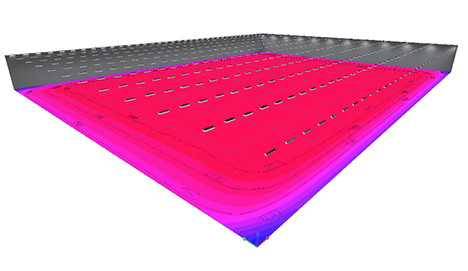Among the various business aspects indoor farmers need to consider, a proper artificial lighting is undoubtedly a key element. While a tailor-made lighting design can be costly, failing to ensure adequate lighting conditions could prove even more expensive. If plants do not receive the right kind and amount of light, that may jeopardize the business itself.
Helping growers grade a lighting design and educating them on the key steps of the engineering process is vital, says Keith Thomas, commercial director at the Tungsram’s Agritech division. During the installation of a new lighting solution, the initial step is to determine the specific objective. Is the aim receiving more light using the same amount of electricity, reducing energy consumption or increasing the yield, size and nutritional values of plants? Or is the goal to reach the highest possible light homogeneity? These targets may not always be compatible. “If we want to be precise, each scenario calls for a different approach," explains Kristóf Rakonczai, lighting design engineer at Tungsram Agritech.
From natural irradiation to the right lamp
It is of outstanding importance to determine the minimum targeted light hours and the DLI (Daily Light Integral) requirement for the given crop during light deprived periods of the year. The objective of installing supplemental lighting is to fill the gap between the lowest level of natural irradiation and targeted DLI.
Selecting the right lamp is the alpha and omega of a lighting design and this requires establishing the ratio between HPS and LED, toplight and interlight luminaries. When opting for an exclusively LED solution, it is worth bearing in mind that different light spectrums deliver different PPF outputs for the same wattage. LED luminaries provide optimal lighting for the crop in terms of spectrum and intensity, and this combined with the right climate conditions can maximize results. A properly executed lighting design is based on the measurable parameters of the growing facility (see below).
Methods used for calculating the values underlying the lighting design are also of key importance. When assessing light homogeneity, it is critical to see the density and position of reference points at canopy level where the PPFD is measured. At the outer edges of the growing area light intensity from artificial lighting usually drops off, but given that these areas in a greenhouse receive more natural light as it is, the sum light level of the canopy may be equalized. Experts recommend examining specific sections of a greenhouse rather than the whole measured area. Following this logic, it is enough to engineer a typical middle or side sector and then multiply it for the whole greenhouse.

Although solutions may vary from company to company, a quality lighting design handout is always based on a number of critical considerations and contains several elements, Kristóf Rakonczai stresses. These include the detailed position of the luminaries, the length and width of the calculated area, the density of reference points, the distance between canopy and the glass of the lamp, as well as average, min-max PPFD values expressed in µmol m-2 s-1, light homogeneity and the lightmap.
Even though some elements of a lighting solution may seem self-evident, it is critically important to seek assistance from professional experts for a lighting solution tailored to a given location, Tungsram Agritech Commercial Director Keith Thomas concludes.
Click here for the key lighting design parameters for glasshouses.
For more information:
Tungsram
Lőrinc Utasi
Agronomist
[email protected]
Keith Thomas
Commercial Leader
[email protected]
